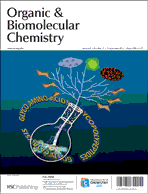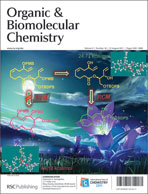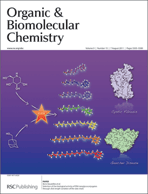Work from Srinivas Hotha at the Indian Institute of Science Education & Research, and colleagues at the National Chemical Laboratory (Pune, India) features on the front cover of Issue 17. Their paper describes the efficient preparation of glycosylated amino acids using propargyl orthoesters as glycosyl donors, via gold-catalysis.
Are your interests in carbohydrate chemistry, or peptide and glycopeptide chemistry? Then this article is for you!
Facile synthesis of unusual glycosyl carbamates and amino acid glycosides from propargyl 1,2-orthoesters as glycosyl donors
Ashif Y. Shaikh, Gopalsamy Sureshkumar, Debasish Pati, Sayam Sen Gupta and Srinivas Hotha
Org. Biomol. Chem., 2011, 9, 5951-5959
DOI: 10.1039/C1OB05056G
As with all our cover articles, this paper is free to access for 6 weeks – why not download it today.















 On the cover of Issue 14 is work from
On the cover of Issue 14 is work from 
 On our cover this issue is work from Silvia Schenone (University of Genoa, Italy) describing the separation of enantiomers of newly-synthesised A1 adenosine antagonists. The group had previously synthesised a family of pyrazolo[3,4-b]pyridine derivatives, and here show that the enantiomers of the most active compound have different affinity for the receptor.
On our cover this issue is work from Silvia Schenone (University of Genoa, Italy) describing the separation of enantiomers of newly-synthesised A1 adenosine antagonists. The group had previously synthesised a family of pyrazolo[3,4-b]pyridine derivatives, and here show that the enantiomers of the most active compound have different affinity for the receptor. The outside cover features work by Michael Doyle and colleagues at University of Maryland. They talk about catalytic C-H insertion processes in comparison with other approaches for the synthesis of selected synthetic targets, lactones and lactams, which have been of biological or medicinal interest. It is a very interesting and original review article. Read more at
The outside cover features work by Michael Doyle and colleagues at University of Maryland. They talk about catalytic C-H insertion processes in comparison with other approaches for the synthesis of selected synthetic targets, lactones and lactams, which have been of biological or medicinal interest. It is a very interesting and original review article. Read more at
 Leo Radom and collaborators in Australia and Switzerland present in this paper a thorough computational study, which correlates with experimental data, of the stability of a very large series of multiply-substituted carbon-centered radicals. They look at the stabilization and interaction energies and the deviations from additivity of RSEs.
Leo Radom and collaborators in Australia and Switzerland present in this paper a thorough computational study, which correlates with experimental data, of the stability of a very large series of multiply-substituted carbon-centered radicals. They look at the stabilization and interaction energies and the deviations from additivity of RSEs. Why do certain DFT methods give good results for ring-opening reactions while others do not?
Why do certain DFT methods give good results for ring-opening reactions while others do not? Atsushi Ikeda and colleagues describe in this paper, which is the outside cover of
Atsushi Ikeda and colleagues describe in this paper, which is the outside cover of